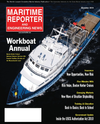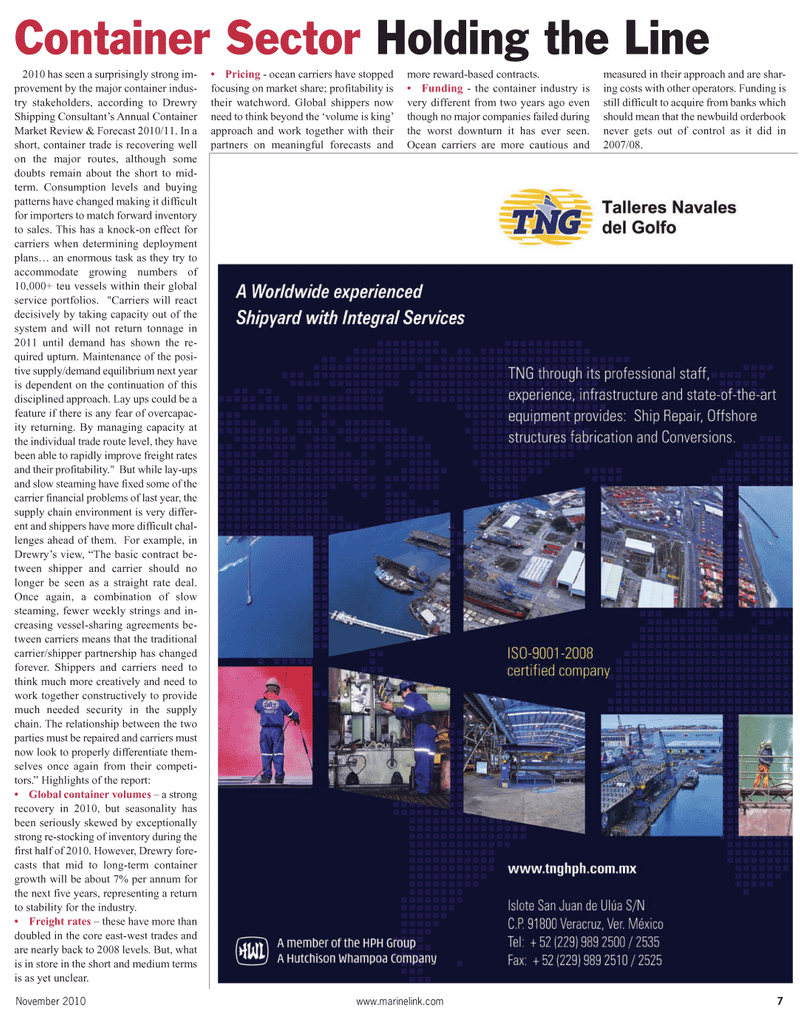
Page 7: of Maritime Reporter Magazine (November 2010)
Workboat Annual
Read this page in Pdf, Flash or Html5 edition of November 2010 Maritime Reporter Magazine
November 2010 www.marinelink.com 7 2010 has seen a surprisingly strong im- provement by the major container indus- try stakeholders, according to Drewry
Shipping Consultant’s Annual Container
Market Review & Forecast 2010/11. In a short, container trade is recovering well on the major routes, although some doubts remain about the short to mid- term. Consumption levels and buying patterns have changed making it difficult for importers to match forward inventory to sales. This has a knock-on effect for carriers when determining deployment plans… an enormous task as they try to accommodate growing numbers of 10,000+ teu vessels within their global service portfolios. "Carriers will react decisively by taking capacity out of the system and will not return tonnage in 2011 until demand has shown the re- quired upturn. Maintenance of the posi- tive supply/demand equilibrium next year is dependent on the continuation of this disciplined approach. Lay ups could be a feature if there is any fear of overcapac- ity returning. By managing capacity at the individual trade route level, they have been able to rapidly improve freight rates and their profitability." But while lay-ups and slow steaming have fixed some of the carrier financial problems of last year, the supply chain environment is very differ- ent and shippers have more difficult chal- lenges ahead of them. For example, in
Drewry’s view, “The basic contract be- tween shipper and carrier should no longer be seen as a straight rate deal.
Once again, a combination of slow steaming, fewer weekly strings and in- creasing vessel-sharing agreements be- tween carriers means that the traditional carrier/shipper partnership has changed forever. Shippers and carriers need to think much more creatively and need to work together constructively to provide much needed security in the supply chain. The relationship between the two parties must be repaired and carriers must now look to properly differentiate them- selves once again from their competi- tors.” Highlights of the report: • Global container volumes – a strong recovery in 2010, but seasonality has been seriously skewed by exceptionally strong re-stocking of inventory during the first half of 2010. However, Drewry fore- casts that mid to long-term container growth will be about 7% per annum for the next five years, representing a return to stability for the industry. • Freight rates – these have more than doubled in the core east-west trades and are nearly back to 2008 levels. But, what is in store in the short and medium terms is as yet unclear. • Pricing - ocean carriers have stopped focusing on market share; profitability is their watchword. Global shippers now need to think beyond the ‘volume is king’ approach and work together with their partners on meaningful forecasts and more reward-based contracts. • Funding - the container industry is very different from two years ago even though no major companies failed during the worst downturn it has ever seen.
Ocean carriers are more cautious and measured in their approach and are shar- ing costs with other operators. Funding is still difficult to acquire from banks which should mean that the newbuild orderbook never gets out of control as it did in 2007/08.
Container Sector Holding the Line

 6
6

 8
8
